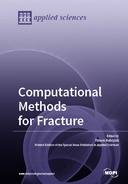Explore

This book offers a collection of 17 scientific papers about the computational modeling of fracture. Some of the manuscripts propose new computational methods and/or how to improve existing cutting edge methods for fracture. These contributions can be classified into two categories: 1. Methods which treat the crack as strong discontinuity such as peridynamics, scaled boundary elements or specific versions of the smoothed finite element methods applied to fracture and 2. Continuous approaches to fracture based on, for instance, phase field models or continuum damage mechanics. On the other hand, the book also offers a wide range of applications where state-of-the-art techniques are employed to solve challenging engineering problems such as fractures in rock, glass, concrete. Also, larger systems such as fracture in subway stations due to fire, arch dams, or concrete decks are studied.
This book is included in DOAB.
Why read this book? Have your say.
You must be logged in to comment.
Rights Information
Are you the author or publisher of this work? If so, you can claim it as yours by registering as an Unglue.it rights holder.Downloads
This work has been downloaded 238 times via unglue.it ebook links.
- 63 - pdf (CC BY-NC-ND) at Unglue.it.
Keywords
- ABAQUS UEL
- anisotropic
- Brittle Fracture
- brittle material
- bulk damage
- cell-based smoothed-finite element method (CS-FEM)
- compressive stress
- concrete creep
- conditioned sandy pebble
- crack shape change
- cracking risk
- cracks
- dam stress zones
- damage
- damage-healing mechanics
- damage-plasticity model
- Discontinuous Galerkin
- Ductility
- Economics, finance, business & management
- elastoplastic behavior
- EPB shield machine
- extended scaled boundary finite element method (X-SBFEM)
- Fatigue
- fatigue crack growth
- FE analysis
- finite element analysis
- finite element simulations
- fluid–structure interaction
- force transfer
- Fracture
- fracture network modeling
- fracture process zone (FPZ)
- FSDT
- geometric phase
- gradient-enhanced model
- grouting
- HSDT
- implicit gradient-enhancement
- incompatible approximation
- Industry & industrial studies
- Information technology industries
- LEFM
- loss of key components
- Media, information & communication industries
- metallic glass matrix composite
- Microstructure
- Mindlin
- moderate fire
- Mohr-Coulomb
- n/a
- Numerical Simulation
- overall stability
- parameters calibration
- particle element model
- peridynamics
- phase field
- Phase-field model
- photonic orbital angular momentum
- plate
- prestressing stress
- progressive collapse analysis
- rail squats
- random fracture
- reinforced concrete core tube
- rock
- rock fracture
- rolling contact
- SBFEM
- screened-Poisson model
- Self-healing
- shear band
- shear failure
- steel reinforced concrete frame
- stress intensity factors
- super healing
- surface crack
- the Xulong arch dam
- thermomechanical analysis
- three-parameter model
- topological insulator
- topological photonic crystal
- XFEM/GFEM
- yielding region
Links
DOI: 10.3390/books978-3-03921-687-1Editions


